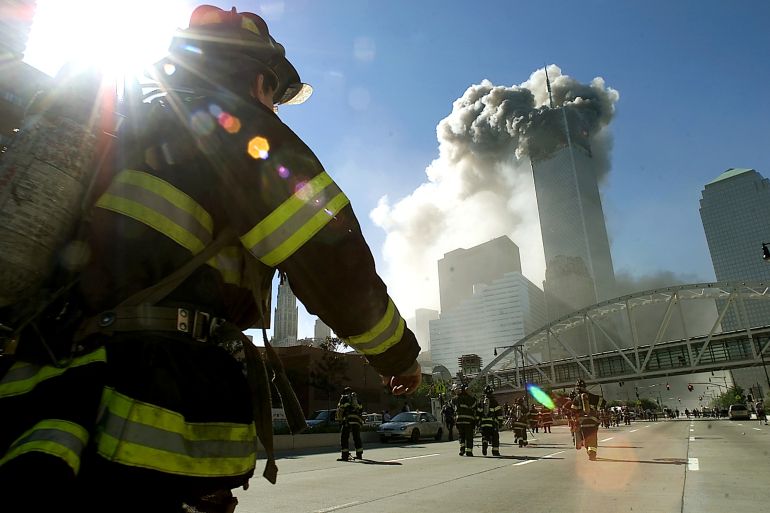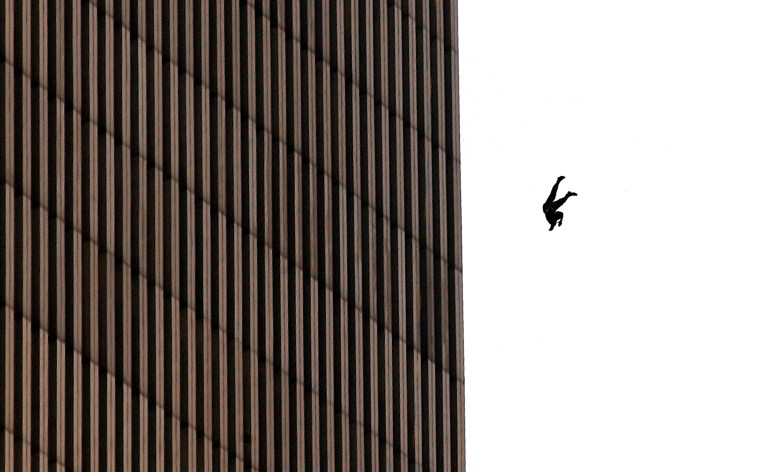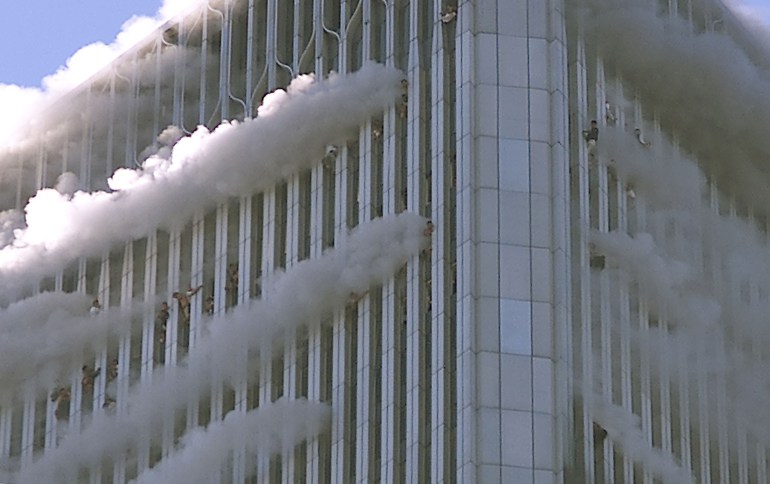Photographing 9/11: ‘What did they think as they jumped?’
‘It was like she was floating. I was so close I could see her face. She didn’t scream.’

WARNING: The following story contains images that may be disturbing to some readers
It was September 2001 and I had been sent to New York to cover a boxing match for a Puerto Rican newspaper. It was a world championship bout between Puerto Rican boxer Felix Trinidad and the American boxer Bernard Hopkins.
Keep reading
list of 3 items9/11 should have led to a criminal investigation, not a war
Decades after 9/11, what became of the US’s neoconservatives?
Trinidad was a good friend of mine and the paper would send me to cover most of his fights. I’d asked not to go on that particular deployment but I was told I had to go.
So, on Saturday, September 8, I boarded a flight from the Puerto Rican capital, San Juan.
The fight was scheduled to take place on the following Saturday at Madison Square Garden.
On the morning of September 11, I headed to Central Park with photojournalists from two other Puerto Rican newspapers. Hopkins’ team had blocked access to his training sessions, which was unusual, but we hoped to spot him training in the park. We agreed that if one of us saw him, we would share the location with the others so we could each get the shots. It worked, and after we’d taken the photographs, we went for breakfast on 53rd Street.
That was when one of those I was with received a call from Puerto Rico telling him a plane had crashed into the World Trade Center. At first, he thought it was a joke. Then my boss called and told me to get to the towers to photograph the crash.
We immediately picked up our cameras and left, asking a taxi to take us to downtown.
By this time, the city – from 14th Street to downtown – had been sealed to everybody except first responders. We got as close as we could but were still some way from the towers. So we jumped out of the taxi, handed the driver a $20 bill and started running along West Broadway towards the towers. As we ran the 35 blocks, weaving in and out of the crowds, we stopped occasionally to photograph the chaos around us.
After about 25 minutes, we were within a block of the towers and there, on a quiet corner between Park Place and West Broadway, I saw a policeman, looking up at the North Tower. There was nobody else around. I took a photo of him – capturing an image of that day that has been widely used since.

As I carried on walking towards the towers, a man in an FBI jacket passed me by. Shortly after, another in a Secret Service jacket walked past. I found it strange that they would be there for a plane crash.
I turned around and started walking towards the West Side Highway, and as I was walking, I saw the first person jump. She was a Black woman, in a smart skirt and vest top. I could see her clearly. It was like she was just floating.
I picked up my camera and took a photo. I remember saying to my fellow photographer Xavier Araujo, “Wow, somebody just jumped.” But he refused to believe me. He thought it was a piece of the building falling. But I was close enough to tell it was a person. I was so close I could see her face. She seemed calm and relaxed, as if she had no other option but to jump. She wasn’t screaming for help or out of fear. I knew I was lucky not to see her hit the pavement.
When we got to the west side of the North Tower, we saw many other people jumping from the windows. Those images have stayed with me, and I often wonder what must have gone through their minds before they decided to jump.
I had been there for about 20 minutes when I heard the terrible sound, like a massive tree branch breaking, as the North Tower crumbled.
I photographed it as it collapsed and it was only then, when it no longer obscured my view, that I realised the South Tower had also fallen completely.
As I ran from the mayhem, I took one frame of a man kneeling on the floor crying, his shirt all torn. I switched lenses and saw a child running and screaming. As I took that frame, it reminded me of the photo of the “Napalm girl” from the Vietnam War.
I realized my digital cards were all full, so I ran a few blocks to the Getty Images office on Varick Street. There, I was uploading the contents of my memory card to a computer when we were told we needed to evacuate the building because the police suspected a bomb had been placed at the Holland Tunnel, adjacent to the office.
I left and took a taxi back to my hotel, from where I filed the photos I had taken. My newspaper ran a late edition that day and used my photos for it.

For the rest of the day, I stayed in my room. I cried a lot. I remember calling my ex-wife but being barely able to speak. Between sobs, I screamed, trying to tell her how many people I had seen jump from the towers.
To this day, I still have no recollection of what I did between 6pm on September 11 and the following morning. It must have been because of the shock.
When I woke up at 6am on September 12, I walked for more than 20 blocks towards the towers. I didn’t see a single person during that walk, not even a dog. I regret not having taken those pictures because I’m sure that was the only time in New York City’s history that the streets were so empty. I wish those images existed, somewhere other than just in my mind, because they were part of the 9/11 story, too.
I spent 21 days covering the 9/11 story before photographing the postponed Trinidad-Hopkins fight on September 29 and finally returning to Puerto Rico.
Today, I still have flashbacks – images of the people standing in the windows before they jumped. I wonder what it was they saw that helped them make peace with that decision.
More importantly, it has always reminded me how fragile we are and that as human beings, we should give respect a chance. All races, cultures and nations should halt this constant creation of scars that has led to so many wars and conflicts such as 9/11.